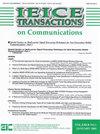Machine Learning in 6G Wireless Communications
IF 0.6
4区 计算机科学
Q3 Engineering
引用次数: 6
Abstract
SUMMARY Mobile communication systems are not only the core of the Information and Communication Technology (ICT) infrastructure but also that of our social infrastructure. The 5th generation mobile communication system (5G) has already started and is in use. 5G is expected for various use cases in industry and society. Thus, many companies and research institutes are now trying to improve the performance of 5G, that is, 5G Enhancement and the next generation of mobile communication systems (Beyond 5G (6G)). 6G is expected to meet various highly demanding requirements even compared with 5G, such as extremely high data rate, extremely large coverage, extremely low latency, extremely low energy, extremely high reliability, extreme massive connectivity, and so on. Arti(cid:12)cial intelligence (AI) and machine learning (ML), AI/ML, will have more important roles than ever in 6G wireless communications with the above extreme high requirements for a diversity of applications, including new combinations of the requirements for new use cases. We can say that AI/ML will be essential for 6G wireless communications. This paper introduces some ML techniques and appli- cations in 6G wireless communications, mainly focusing on the physical layer.6G无线通信中的机器学习
移动通信系统不仅是信息通信技术(ICT)基础设施的核心,也是我们社会基础设施的核心。第5代移动通信系统(5G)已经启动并投入使用。5G有望用于工业和社会的各种用例。因此,现在许多公司和研究机构都在努力提高5G的性能,即5G增强和下一代移动通信系统(超越5G (6G))。与5G相比,6G有望满足各种高要求,如极高的数据速率、极大的覆盖范围、极低的延迟、极低的能耗、极高的可靠性、极海量的连接等。人工智能(AI)和机器学习(ML) (AI /ML)将在6G无线通信中发挥比以往任何时候都更重要的作用,因为上述对各种应用的极高要求,包括对新用例的新要求组合。我们可以说,AI/ML对6G无线通信至关重要。本文介绍了机器学习技术及其在6G无线通信中的应用,重点介绍了机器学习技术的物理层。
本文章由计算机程序翻译,如有差异,请以英文原文为准。
求助全文
约1分钟内获得全文
求助全文
来源期刊

IEICE Transactions on Communications
ENGINEERING, ELECTRICAL & ELECTRONIC-TELECOMMUNICATIONS
CiteScore
1.50
自引率
28.60%
发文量
101
期刊介绍:
The IEICE Transactions on Communications is an all-electronic journal published occasionally by the Institute of Electronics, Information and Communication Engineers (IEICE) and edited by the Communications Society in IEICE. The IEICE Transactions on Communications publishes original, peer-reviewed papers that embrace the entire field of communications, including:
- Fundamental Theories for Communications
- Energy in Electronics Communications
- Transmission Systems and Transmission Equipment for Communications
- Optical Fiber for Communications
- Fiber-Optic Transmission for Communications
- Network System
- Network
- Internet
- Network Management/Operation
- Antennas and Propagation
- Electromagnetic Compatibility (EMC)
- Wireless Communication Technologies
- Terrestrial Wireless Communication/Broadcasting Technologies
- Satellite Communications
- Sensing
- Navigation, Guidance and Control Systems
- Space Utilization Systems for Communications
- Multimedia Systems for Communication
 求助内容:
求助内容: 应助结果提醒方式:
应助结果提醒方式:


